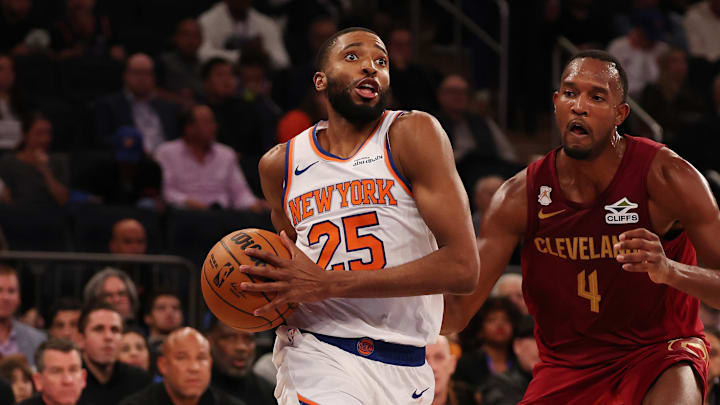So many of the New York Knicks’ offensive changes under Mike Brown were on full display during their Wednesday night victory over the Cleveland Cavaliers. Nobody on the roster drove the team’s evolution home harder than Mikal Bridges.
Evidence is scattered throughout the 29-year-old’s performance, but the most notable proof comes in the form of his shot profile. Last year, around 18.2 percent of his attempts were two-pointers outside the paint. Just one of his 11 shots against the Cavs came from that area.
This aligns perfectly with the Knicks’ overall shot profile, which is de-emphasizing those same looks with more ball and body movement. Over 79 percent of their attempts came at the rim or from beyond the arc. By comparison, New York’s rim-or-three rate last year checked in nearly 11 percentage points lower, at 68.2, when factoring in the playoffs.
And that’s just the tip of the iceberg.
Mikal Bridges is helping unlock a different version of Jalen Brunson
Loads of attention is being paid to how the Knicks deployed Jalen Brunson in Game No. 1. Rightfully so. After being on-ball more than anyone else last year, Brunson basically shouldered his lightest self-creation workload since joining the team:
Last season, no one had the ball in their hands more often than Brunson. Mike Brown made it known that he wanted to get Brunson easier looks this season. While the shot wasn't always there tonight, there was a clear effort to get Brunson off the ball more/get him easier looks. pic.twitter.com/4TwDXxikvl
— ALL NBA Podcast (@ALLCITY_NBA) October 23, 2025
All the usual “It’s only one game!” caveats apply here. But this is an extension of what we saw happen during the preseason. In some form or another, Brunson’s role is clearly going to change under Mike Brown.
Bridges is already helping make it possible. The Knicks are putting the ball in his hands to initiate more than we’re used to seeing. Against Cleveland, he averaged what amounts to 4.4 minutes of possession time per 36 minutes of game action. If this becomes the new normal, it would roughly double the 2.2 minutes of possession time per 36 minutes of game action he averaged in 2024-25.
Giving him more work on the rock doesn’t render New York’s secondary-playmaking problem a sudden strength. But having someone, anyone, to displace Brunson from the ball is important. Bridges is more likely to become that guy if he plays like he did Wednesday.
This includes getting deeper into the paint on his drives. Five of his 11 shots came at the basket. Many of those were off cuts and in transition. But his nine drives in 33 minutes against the Cavs represent a stark uptick from last year’s average of 6.3 in 37, and he’s getting two feet in the paint on them more often to boot.
Mikal Bridges has a license to run
Although the Knicks didn’t blow the Cavs out of the water with transition offense, they did pick their spots. Their speed after Cleveland missed a two-pointer, in particular, was head-turning.
New York’s averaged offensive possession lasted around eight seconds in those situations. It was closer to 11 in those instances last year.
For Bridges’ part, he spent noticeably more time out in transition than last season. He clearly has more agency to grab and go, or is at least more inclined to do so, than last season.
It all amounted to a more complete offensive performance than is typical. Bridges did not join in on the three-point inflation (three attempts), but everything from his driving, initiation, passing, shot profile, and even spending less time defending at the point of attack stood out—both because he looked (mostly) at home doing it, and because his entire performance is a harbinger of the Knicks’ more variable, egalitarian approach to, well, just about everything.
